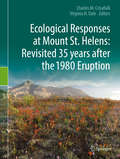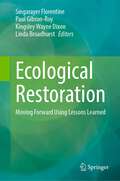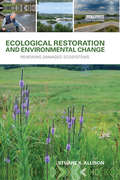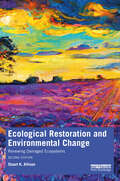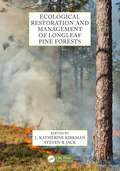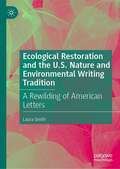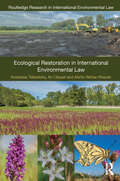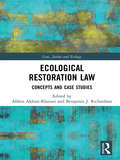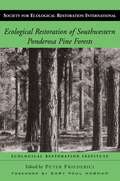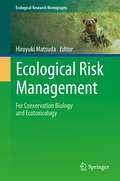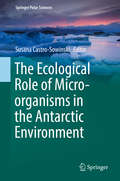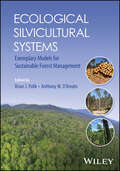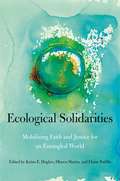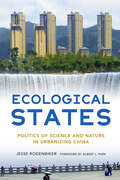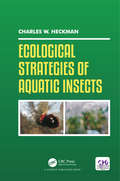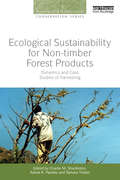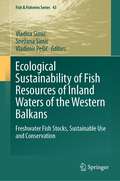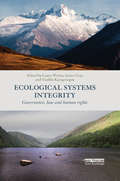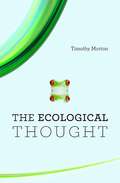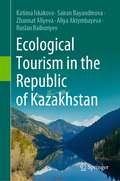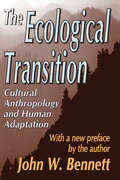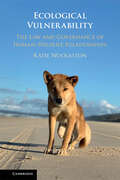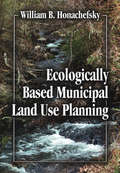- Table View
- List View
Ecological Responses at Mount St. Helens: Revisited 35 years after the 1980 Eruption
by Virginia H. Dale Charles M. CrisafulliThis book builds on existing work exploring succession, disturbance ecology, and the interface between geophysical and biological systems in the aftermath of the 1980 eruptions of Mount St. Helens. The eruption was dramatic both in the spatial extent of impacts and the range of volcanic disturbance types and intensities. Complex geophysical forces created unparalleled opportunities to study initial ecological responses and long-term succession processes that occur in response to a major contemporary eruption across a great diversity of ecosystems--lowland to alpine forests, meadows, lakes, streams, and rivers. These factors make Mount St. Helens an extremely rich environment for learning about the ecology of volcanic areas and, more generally, about ecosystem response to major disturbance of many types, including land management. Lessons about ecological recovery at Mount St. Helens are shaping thought about succession, disturbance ecology, ecosystem management, and landscape ecology. In the first five years after the eruption several syntheses documented the numerous, intensive studies of ecological recovery. The 2005 volume "Ecological Responses to the 1980 Eruption of Mount St. Helens" (Springer Publishing) was the first ecological synthesis since 1987 of the scores of ecological studies underway in the area. More than half of the world's published studies on plant and animal responses to volcanic eruptions have taken place at Mount St. Helens. The 25-year synthesis, which generally included investigations (i. e. , data) from 1980-2000, made it possible to more thoroughly analyze initial stages of ecological responses and to test the validity of early interpretations and the duration of early phenomena. And 35 years after the eruption, it is time for many of the scientists working in the first three-decade, post-eruption period to pass the science baton to the next generation of scientists to work at Mount St. Helens, and a synthesis at this time of transfer of responsibility to a younger cohort of scientists will be an enormous asset to the continuation of work at the volcano.
Ecological Restoration: Moving Forward Using Lessons Learned
by Singarayer Florentine Paul Gibson-Roy Kingsley Wayne Dixon Linda BroadhurstEcological restoration, although a relatively new endeavour compared to other disciplines, has gained significant momentum during the last decade as accelerating global change becomes more apparent. It is now widely accepted by the scientific community that to avoid further devastating effects of climate change and biodiversity loss, humanity must determinedly move more to protect and restore natural ecosystems. Many restoration efforts of the past have been ad hoc, site and situation-specific and have often failed to achieve desired outcomes, but over the last decade, many countries are allocating increasingly significant amounts of financial investment towards restoration with the goal of achieving more systematic and predictable outcomes. Today, activities related to restoring ecosystems, natural assets and biodiversity are a global focus. This book covers a wide range of topics related to ecological restoration including for grasslands, wetlands, temperate and tropical forests and arid zones. Importantly, it also focuses on ecological restoration in human-disturbed landscapes such as for urban areas, farmlands, mine sites and transport corridors. It highlights the necessity for evidence-based approaches that are both nuanced and complementary with prescriptions for people-based restoration, that is socially inclusive and cognisant of historic and current community sentiment. Ambitious landscape and continental scale targets for ecological restoration have been set across the globe. However, without practical guidelines developed from restoration evaluations from the recent past to follow, future efforts are unlikely to be successful, nor -expected targets met. To that end, this book reviews and highlights a large number and variety of restoration stories from around the world. Most are presented as reader-friendly case studies, that feature innovative and systematic techniques for undertaking species-rich ecological restoration. Together they provide inspiration for current and future professionals and offer unique glimpses into state-of-the-art practice for this critically important discipline
Ecological Restoration and Environmental Change: Renewing Damaged Ecosystems
by Stuart K. AllisonWhat is a natural habitat? Who can define what is natural when species and ecosystems constantly change over time, with or without human intervention? When a polluted river or degraded landscape is restored from its damaged state, what is the appropriate outcome? With climate change now threatening greater disruption to the stability of ecosystems, how should restoration ecologists respond? Ecological Restoration and Environmental Change addresses and challenges some of these issues which question the core values of the science and practice of restoration ecology. It analyzes the paradox arising from the desire to produce ecological restorations that fit within an historical ecological context, produce positive environmental benefits and also result in landscapes with social meaning. Traditionally restorationists often felt that by producing restorations that matched historic ecosystems they were following nature's plans and human agency played only a small part in restoration. But the author shows that in reality the process of restoration has always been defined by human choices. He examines the development of restoration practice, especially in North America, Europe and Australia, in order to describe different models of restoration with respect to balancing ecological benefit and cultural value. He develops ways to balance more actively these differing areas of concern while planning restorations. The book debates in detail how coming global climate change and the development of novel ecosystems will force us to ask new questions about what we mean by good ecological restoration. When the environment is constantly shifting, restoration to maintain biodiversity, local species, and ecosystem functions becomes even more challenging. It is likely that in the future ecological restoration will become a never-ending, continuously evolving process.
Ecological Restoration and Environmental Change: Renewing Damaged Ecosystems
by Stuart K. AllisonEcological Restoration and Environmental Change presents an introduction to the practice of renewing and restoring degraded, damaged, or destroyed ecosystems and habitats in the environment. The book addresses and challenges key issues which question the core values of the science and practice of restoration ecology. The author explains that the process of restoration has always been defined by human choices and examines the development of restoration practice, to describe different models of restoration with respect to balancing ecological benefit and cultural value. He develops ways to balance more actively these differing areas of concern while planning restorations. This new edition has been fully revised and updated to reflect changes in the field and the new challenges posed to restoration ecology in the face of the rapid pace of climate change. With strong coverage of North and South American, Europe, and Australia, this new edition has been expanded to also address indigenous perspectives and restoration projects in Africa, the Pacific Islands, and Asia. It places special emphasis on the need for restorationists to appreciate and understand the intricacies of planning and managing restorations in novel ecosystems. Lastly, it provides a critique of the new restoration standards published by the Society for Ecological Restoration in 2019. This book is essential reading for students on restoration ecology and conservation courses, as well as professionals and practitioners working on restoration projects.
Ecological Restoration and Management of Longleaf Pine Forests
by L. Katherine Kirkman Steven B. JackEcological Restoration and Management of Longleaf Pine Forests is a timely synthesis of the current understanding of the natural dynamics and processes in longleaf pine ecosystems. This book beautifully illustrates how incorporation of basic ecosystem knowledge and an understanding of socioeconomic realities shed new light on established paradigms and their application for restoration and management. Unique for its holistic ecological focus, rather than a more traditional silvicultural approach, the book highlights the importance of multi-faceted actions that robustly integrate forest and wildlife conservation at landscape scales, and merge ecological with socioeconomic objectives for effective conservation of the longleaf pine ecosystem.
Ecological Restoration and the U.S. Nature and Environmental Writing Tradition: A Rewilding of American Letters
by Laura SmithThis book presents a critical history of the intersections between American environmental literature and ecological restoration policy and practice. Through a storying—restorying—restoring framework, this book explores how entanglements between writers and places have produced literary interventions in restoration politics. The book considers the ways literary landscapes are politicized by writers themselves, and by conservationists, activists, policymakers, and others, in defense of U.S. public lands and the idea of wilderness. The book profiles five environmental writers and examines how their writings on nature, wildness, wilderness, conservation, preservation, and restoration have variously inspired and been translated into ecological restoration programs and campaigns by environmental organizations. The featured authors are Henry David Thoreau (1817–1862) at Walden Pond, John Muir (1838–1914) in Yosemite National Park, Aldo Leopold (1887–1948) at his family’s Wisconsin sand farm, Marjory Stoneman Douglas (1890–1998) in the Everglades, and Edward Abbey (1927–1989) in Glen Canyon. This book combines environmental history, literature, biography, philosophy, and politics in a commentary on considering (and developing) environmental literature’s place in conversations on restoration ecology, ecological restoration, and rewilding.
Ecological Restoration in International Environmental Law (Routledge Research in International Environmental Law)
by Anastasia Telesetsky Afshin Akhtar-Khavari An CliquetHuman activities are depleting ecosystems at an unprecedented rate. In spite of nature conservation efforts worldwide, many ecosystems including those critical for human well-being have been damaged or destroyed. States and citizens need a new vision of how humans can reconnect with the natural environment. With its focus on the long-term holistic recovery of ecosystems, ecological restoration has received increasing attention in the past decade from both scientists and policymakers. Research on the implications of ecological restoration for the law and law for ecological restoration has been largely overlooked. This is the first published book to examine comprehensively the relationship between international environmental law and ecological restoration. While international environmental law (IEL) has developed significantly as a discipline over the past four decades, this book enquires whether IEL can now assist states in making a strategic transition from not just protecting and maintaining the natural environment but also actively restoring it. Arguing that states have international duties to restore, this book offers reflections on the philosophical context of ecological restoration and the legal content of a duty to restore from an international law, European Union law and national law perspective. The book concludes with a discussion of several contemporary themes of interest to both lawyers and ecologists including the role of private actors, protected areas and climate change in ecological restoration.
Ecological Restoration Law: Concepts and Case Studies (Law, Justice and Ecology)
by Afshin Akhtar-Khavari Benjamin J. RichardsonEcological restoration is as essential as sustainable development for the health of the biosphere. Restoration, however, has been a low priority of most countries' environmental laws, which tend to focus narrowly on rehabilitation of small, discrete sites rather than the more ambitious recovery of entire ecosystems and landscapes. Through critical theoretical perspectives and topical case studies, this book's diverse contributors explore a more ambitious agenda for ecological restoration law. Not only do they investigate current laws and other governance mechanisms; they also consider the philosophical and methodological bases for the law to take ecological restoration more seriously. Through exploration of themes relating to time, space, geography, semiotics, social justice, and scientific knowledge, this book offers innovative and critical insights into ecological restoration law.
Ecological Restoration of Southwestern Ponderosa Pine Forests (Science Practice Ecological Restoration #2)
by Gary Paul Nabhan Peter Friederici Peter Ecological Restoration InstituteEcological Restoration of Southwestern Ponderosa Pine Forests brings together practitioners and thinkers from a variety of fields--including forestry, biology, philosophy, ecology, political science, archaeology, botany, and geography--to synthesize what is known about ecological restoration in ponderosa pine forests and to consider the factors involved in developing and implementing a successful restoration effort. The book examines:* the overall context for restoration--ecological, social, economic, political, and philosophical* how ecosystem processes such as fire, hydrology, and nutrient cycling are affected by restoration activities* treatment effects on specific ecosystem components such as trees, understory plants, animals, and rare or invasive species* the details of implementing restoration projects, including smoke management, the protection of cultural resources, and monitoringEach section is introduced with a case study that demonstrates some of the promise and pitfalls of restoration projects.Ecological Restoration of Southwestern Ponderosa Pine Forests is the second book in the series The Science and Practice of Ecological Restoration from the Society for Ecological Restoration International and Island Press.
Ecological Reviews: Conflicts in Conservation
by Redpath, Stephen M. and Gutiérrez, R. J. and Wood, Kevin A. and Young, Juliette C. Stephen M. Redpath R. J. Gutiérrez Kevin A. Wood Juliette C. YoungConflicts over the conservation of biodiversity are increasing and are serious obstacles to wildlife conservation efforts worldwide. Changing patterns in land use, over-exploitation, pollution, climate change and the threat posed by invasive species all challenge the way we currently maintain and protect biodiversity - from the local management of single species to the international management of resources. Integrating approaches from different academic disciplines, policy makers and practitioners, this volume offers a radically new, cross-disciplinary, multi-scale approach to deal with conflicts. Groundbreaking strategies for conservation are analysed and a large section of the book is devoted to exploring case studies of conflict from around the world. Aimed primarily at academics, researchers and students from disciplines relating to conservation, ecology, natural resources management and environmental governance, this book will be equally valuable to conservation NGOs and practitioners, and the policy community at national and international levels.
Ecological Risk Management: For Conservation Biology and Ecotoxicology (Ecological Research Monographs)
by Hiroyuki MatsudaThis book introduces the theory and practice of ecological risk management. Using recent and live case studies in Japan, the book explains the use of basic mathematical techniques in extinction risk, adaptive population management, avian collision risk in wind farms, potential biological removal for marine mammals, and ecological risk assessment of heavy metals. The focus of this book is on case studies of nature conservation in Japan, including internationally renowned topics of Japanese fisheries, Shiretoko World Heritage, Fukushima Daiichi Nuclear Power Plant accident. It also covers the adaptive risk management of the new coronavirus disease.The book comprises four parts covering ecotoxicology, fisheries, wildlife management and conservation, and ecosystem-based management. It differs from other books in having its primary interest in human impacts on animals, plant, and ecosystems, while existing works in this area concentrate on the fate of toxic substances in the environments and their effects on humans. This book is unique in that it indicates various environmental issues that the theoretical ecology is potentially applicable without concentrating into any particular subject such as ecotoxicology or conservation biology. Primary readers are undergraduate/graduate students, staffs of environmental consultant companies and environmental NPOs, and journalists. Readers will find this book useful for its abundant information on case studies of ecological risk management and consensus building in Japan.
The Ecological Role of Micro-organisms in the Antarctic Environment (Springer Polar Sciences)
by Susana Castro-SowinskiThis book provides up-to-date multidisciplinary information regarding microbial physiological groups in terms of their role in the Antarctic ecology. How do microorganisms shape the Antarctic environment? The book presents a thorough overview of the most important physiological microbial groups or microbial systems that shape the Antarctic environment. Each microbial model is described in terms of their physiology and metabolism, and their role in the Antarctic environmental sustainability. The individual chapters prepare readers for understanding the relevance of the microbial models from both an historical perspective, and considering the latest developments. This book will appeal to researchers and teachers interested in the Antarctic science, but also to students who want to understand the role of microbes in the ecology of extreme environments.
Ecological Silvicultural Systems: Exemplary Models for Sustainable Forest Management
by Brian J. Palik Anthony W. D’AmatoECOLOGICAL SILVICULTURAL SYSTEMS Unleash the natural power and adaptability of forests with this cutting-edge guide For generations, silvicultural systems have focused largely on models whose primary objective is the production of timber, leading to drastically simplified forests with reduced ecological richness, diversity, and complexity. Ecological silviculture, by contrast, focuses on producing and maintaining forests with “all their parts”—, that is, with the diversity and flexibility to respond and adapt to global changes. Ecological silviculture seeks to emulate natural development models and sustain healthy forests serving multiple values and goals. Ecological Silvicultural Systems provides a comprehensive introduction to these approaches and their benefits tailored to diverse types of forests, designed for forest management professionals. It provides a series of exemplary models for ecological silviculture and surveys the resulting forest ecosystems. The result is a text that meets the needs of professionals in forestry and natural resource management with an eye towards sustaining healthy forest ecosystems, adapting them to climate change, protecting them from invasive species, and responding to changing market forces. Ecological Silvicultural Systems readers will also find: Detailed treatment of forest ecosystems in North America, Europe, South America, and Australia A broad field of contributors with decades of combined expertise on multiple continents Discussion of pine woodlands; temperate hardwood forests, boreal forests, temperate rainforests, and more Ecological Silvicultural Systems is a useful reference for professional foresters, wildlife habitat managers, restoration ecologists, and undergraduate and graduate students in any of these fields.
Ecological Solidarities: Mobilizing Faith and Justice for an Entangled World (World Christianity #1)
by Krista E. HughesOperating on the premise that our failure to recognize our interconnected relationship to the rest of the cosmos is the origin of planetary peril, this volume presents academic, activist, and artistic perspectives on how to inspire reflection and motivate action in order to construct alternative frameworks and establish novel solidarities for the sake of our planetary home.The selections in this volume explore ecologies of interdependence as a frame for religious, theological, and philosophical analysis and practice. Contributors examine questions of justice, climate change, race, class, gender, and coloniality and discuss alternative ways of engaging the world in all its biodiversity. Each essay, poem, reflection, and piece of art contributes to and reflects upon how to live out entangled differences toward positive global change.Constructive and practical, global and local, communal and personal, Ecological Solidarities is an innovative contribution to the discourses on relational and liberative thought and practice in religion, philosophy, and theology. It will be welcomed by scholars of World Christianity and theology as well as seminary students, activists, and laity interested in issues of justice and ecology.
Ecological Solidarities: Mobilizing Faith and Justice for an Entangled World (World Christianity)
by Krista E. HughesOperating on the premise that our failure to recognize our interconnected relationship to the rest of the cosmos is the origin of planetary peril, this volume presents academic, activist, and artistic perspectives on how to inspire reflection and motivate action in order to construct alternative frameworks and establish novel solidarities for the sake of our planetary home.The selections in this volume explore ecologies of interdependence as a frame for religious, theological, and philosophical analysis and practice. Contributors examine questions of justice, climate change, race, class, gender, and coloniality and discuss alternative ways of engaging the world in all its biodiversity. Each essay, poem, reflection, and piece of art contributes to and reflects upon how to live out entangled differences toward positive global change.Constructive and practical, global and local, communal and personal, Ecological Solidarities is an innovative contribution to the discourses on relational and liberative thought and practice in religion, philosophy, and theology. It will be welcomed by scholars of World Christianity and theology as well as seminary students, activists, and laity interested in issues of justice and ecology.
Ecological States: Politics of Science and Nature in Urbanizing China (The Environments of East Asia)
by Jesse RodenbikerEcological States critically examines ecological policies in the People's Republic of China to show how campaigns of scientifically based environmental protection transform nature and society. While many point to China's ecological civilization programs as a new paradigm for global environmental governance, Jesse Rodenbiker argues that ecological redlining extends the reach of the authoritarian state.Although Chinese urban sustainability initiatives have driven millions of citizens from their land and housing, Rodenbiker shows that these migrants are not passive subjects of state policy. Instead, they creatively navigate resettlement processes in pursuit of their own benefit. However, their resistance is limited by varied forms of state-backed infrastructural violence. Through extensive fieldwork with scientists, urban planners, and everyday citizens in southwestern China, Ecological States exposes the ways in which the scientific logics and practices fundamental to China's green urbanization have solidified state power and contributed to dispossession and social inequalityWith support from the Henry Luce Foundation, our goal is to produce all titles in this series both in Open Access, for reasons of global accessibility and equity, as well as in print editions.
Ecological Strategies of Aquatic Insects
by Charles W. HeckmanThis book recounts the habits of many interesting and unusual exceptions to the rule that insects are typically terrestrial forms of life. It examines the different ways that groups of species have developed modes of existence in or on the surface of water, and gives reasons why the gross morphology of insects is not favorable for life in or near bodies of water, such as wings that fail to function after coming into contact with water, rendering them useless.
Ecological Sustainability for Non-timber Forest Products: Dynamics and Case Studies of Harvesting (People and Plants International Conservation)
by Charlie M. Shackleton Ashok K. Pandey Tamara TicktinThere is growing knowledge about and appreciation of the importance of Non-timber Forest Products (NTFPs) to rural livelihoods in developing countries, and to a lesser extent, developed countries. However, there is also an assumption on the part of policy-makers that any harvesting of wild animal or plant products from the forests and other natural and modified ecosystems must be detrimental to the long-term viability of target populations and species. This book challenges this idea and shows that while examples of such negative impacts certainly exist, there are also many examples of sustainable harvesting systems for NTFPs. The chapters review and present coherent and scientifically sound information and case studies on the ecologically sustainable use of NTFPs. They also outline a general interdisciplinary approach for assessing the sustainability of NTFP harvesting systems at different scales. A wide range of case studies is included from Africa, Asia and South America, using plant and animal products for food, crafts, textiles, medicines and cosmetics.
Ecological Sustainability of Fish Resources of Inland Waters of the Western Balkans: Freshwater Fish Stocks, Sustainable Use and Conservation (Fish & Fisheries Series #43)
by Vladica Simić Snežana Simić Vladimir PešićThis book provides a detailed evaluation of the hydro-ecological characteristics of the Western Balkans, an area characterized by still preserved inland waters and fish resources important for the European continent, as well as the biodiversity of inland waters important for the planet Earth. Freshwater ecosystems cover only 1% of the Earth's surface; however, they are a habitat for about 40% of fish species. At the same time, inland fisheries make less than 12% of the world's global fish catch, with 43% coming from low-income and food-deficient countries (Africa, South America, Southeast Asia). In Europe, the Western Balkans have significant fishing waters and fish resources, including the Middle Danube drainage (Sava, Drina, Velika Morava river systems), large ancient lakes (Skadar/Shkodra, Ohrid, Prespa, Dojran), and the Adriatic basin characterized by endemic and commercially important species. However, in contrast to the high fishing potential in a significant part of the Western Balkans, diverse and specific political, economic, and social factors largely had a negative impact on the state of fish resources. This volume is multidisciplinary and provides a sound knowledge base for scientific and practical fisheries. In addition, it may be a valuable guide for managers and conservationists worldwide to adapt methods and procedures for the ecological sustainability of fish resources under specific local, natural, and socio-economic conditions. Finally, the content is a good reference for natural sciences and agriculture students studying fish, fish resources, and fisheries sciences. It would improve their knowledge and perspectives on the challenges of sustainable use and conservation of inland water resources.
Ecological Systems Integrity: Governance, law and human rights
by Laura Westra, Janice Gray and Vasiliki KarageorgouEnvironmental law and governance are the cornerstones of global efforts to conserve the environment, protect resources and ensure fair and equitable outcomes for all of the planet's inhabitants. This book presents a series of thought-provoking chapters which consider the place of governance and law in the defence against imminent and ongoing threats to ecological, social and cultural integrity. Written by an international team of both established and early-career scholars from various disciplines and backgrounds, the chapters cover the most pressing and contemporary issues in environmental law and governance. These include access and benefit-sharing; the right to food and water; climate change coping and adaptation; human rights; the rights of indigenous communities; public and environmental health; and many more. The book has a general focus on environmental governance and law in the European Union and offers points of comparison with Canada and North and South America.
The Ecological Thought
by Timothy MortonIn this passionate, lucid, and surprising book, Timothy Morton argues that all forms of life are connected in a vast, entangling mesh. This interconnectedness penetrates all dimensions of life. No being, construct, or object can exist independently from the ecological entanglement, Morton contends, nor does “Nature” exist as an entity separate from the uglier or more synthetic elements of life. Realizing this interconnectedness is what Morton calls the ecological thought.<P> In three concise chapters, Morton investigates the profound philosophical, political, and aesthetic implications of the fact that all life forms are interconnected. As a work of environmental philosophy and theory, The Ecological Thought explores an emerging awareness of ecological reality in an age of global warming. Using Darwin and contemporary discoveries in life sciences as root texts, Morton describes a mesh of deeply interconnected life forms—intimate, strange, and lacking fixed identity.<P> A “prequel” to his Ecology without Nature: Rethinking Environmental Aesthetics (Harvard, 2007), The Ecological Thought is an engaged and accessible work that will challenge the thinking of readers in disciplines ranging from critical theory to Romanticism to cultural geography.
Ecological Tourism in the Republic of Kazakhstan
by Katima Iskakova Sairan Bayandinova Zhannat Aliyeva Aliya Aktymbayeva Ruslan BaiburiyevThis book analyses the theoretical and methodological foundations of ecotourism and geotourism and examines the essence, content, factors, and models of ecotourism development. The authors conducted research to assess the tourist and recreational potential of ecotourism in Kazakhstan. The study analyses the current state and describes the problems of the long-term development of ecotourism. Besides, the authors also show the role of specially protected natural areas in ecotourism development, including a list of organizations that can create tourist products in the environmental direction. This book also defines the primary conditions necessary for ecotourism in protected natural and rural areas. The resulting cartographic material visualizes the geospatial potential of the regions of Kazakhstan, aiming a more targeted expenditure of financial resources allocated to tourism development. Thus, the presented book is relevant from a practical perspective to scientists and researchers and is of value to business structures and stakeholders.
The Ecological Transition: Cultural Anthropology and Human Adaptation
by John W. BennettWritten during the height of the ecology movement, The Ecological Transition is a stunning interdisciplinary work. It combines anthropology, ecology, and sociology to formulate an understanding of cultural-environmental relationships. While anthropologists have been studying relationships between humans and the physical environment for a very long time, only in the last thirty years have questions inherent in these relationships broadened beyond description and classification. For example, the concept of environment has been extended beyond the physical into the social.Although anthropologists have adopted many of the concepts that Bennett develops in the book, he also feels that the central issues have never been addressed, either by anthropologists or by people in related disciplines. The most important of these, in Bennett's opinion, is the failure to incorporate a respect for the environmental in contemporary culture, which would allow making exceptions in certain human practices in order to protect the environment. His point in The Ecological Transition is that a basic cultural change in modern civilization is necessary to achieve this end.Both a theoretical and a practical work, The Ecological Transition emphasizes the relationships between human culture, the physical environment, technology, and social policy. The Ecological Transition is a challenging volume that makes us face the consequences of human behavior in the modern world: its effect on pollution, natural resources, agriculture, the economy, and population, to name just a few areas. The book remains a significant contribution to the discourse on social, economic, and environmental problems. While the book was first published in 1976, it still reads as a contemporary tract.
Ecological Vulnerability: The Law and Governance of Human–Wildlife Relationships
by Katie WoolastonHumans are responsible for biodiversity loss in many related and sometimes conflicting ways. Human-wildlife conflict, commonly defined as any negative interaction between people and wildlife, is a primary contributor to wildlife extinction and a manifestation of the destructive relationship that people have with wildlife. The author presents this 'wicked' problem in a social and legal context and demonstrates that legal institutions structurally deny human-wildlife conflict, while exacerbating conflict, promoting values consistent with individual autonomy, and ignoring the interconnected vulnerabilities shared by human and non-human species alike. It is the use of international and state law that sheds light on existing conflicts, including dingo conflict on K'Gari-Fraser Island in Australia, elephant conflict in Northern Botswana, and the global wildlife trade contributing to COVID-19. This book presents a critical analysis of human-wildlife conflict and its governance, to guide lawyers, scientists and conservations alike in the transformation of the management of human-wildlife conflict.
Ecologically Based Municipal Land Use Planning
by William B HonachefskyIn the decades following the first Earth Day in 1970, a generation has been enlightened about the unspeakable damage done to our planet. Federal, state, and local governments generated laws and regulations to control development and protect the environment. Local governments have developed environmental standards addressing their needs. The result-an ecologically incongruous pattern of land development known as urban sprawl.Local land use planners can have a greater effect on the quality of our environment than all of the federal and state regulators combined. Historically, they have existed on the periphery of land management. The author suggests that federal and state environmental regulators need to incorporate local governments into their environmental protection plans. Ecologically Based Municipal Land Use Planning provides easily understood, nuts and bolts solutions for controlling urban sprawl, emphasizing the integration of federal, state, and local land use plans.The book discusses ecological resources and provides practical solutions that municipal planners can implement immediately. It discusses the most recent scientific data, how to extract what is important, and how to apply it to the local land planning process. The author includes the application of the Geographic Information Systems (GIS) to problem solving.Despite compelling evidence and sound arguments favoring the implementation of an ecologically sensitive approach to land use planning, municipal planners, in general, remain skeptical. It will take considerably more encouragement and education to win them over completely. Ecologically Based Municipal Land Use Planning makes the case for sound land use policies that will reduce sprawl.
